《概率论与数理统计》课程教学资源(阅读材料)A short history of probability
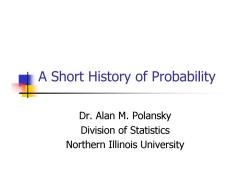
A Short History of Probability Dr.Alan M.Polansky Division of Statistics Northern Illinois University
A Short History of Probability Dr. Alan M. Polansky Division of Statistics Northern Illinois University
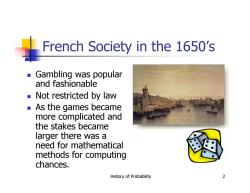
French Society in the 1650's Gambling was popular and fashionable ■Not restricted by law ■As the games became more complicated and the stakes became larger there was a need for mathematical methods for computing chances. History of Probability 2
History of Probability 2 French Society in the 1650’s ! Gambling was popular and fashionable ! Not restricted by law ! As the games became more complicated and the stakes became larger there was a need for mathematical methods for computing chances
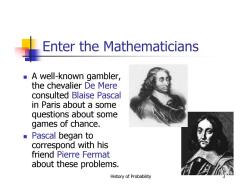
Enter the Mathematicians A well-known gambler, the chevalier De Mere consulted Blaise Pascal in Paris about a some questions about some games of chance. ■ Pascal began to correspond with his friend Pierre Fermat about these problems. History of Probability
History of Probability 3 Enter the Mathematicians ! A well-known gambler, the chevalier De Mere consulted Blaise Pascal in Paris about a some questions about some games of chance. ! Pascal began to correspond with his friend Pierre Fermat about these problems
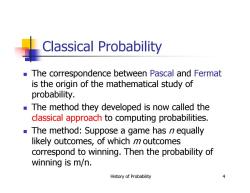
Classical Probability The correspondence between Pascal and Fermat is the origin of the mathematical study of probability. The method they developed is now called the classical approach to computing probabilities. The method:Suppose a game has n equally likely outcomes,of which m outcomes correspond to winning.Then the probability of winning is m/n. History of Probability 4
History of Probability 4 Classical Probability ! The correspondence between Pascal and Fermat is the origin of the mathematical study of probability. ! The method they developed is now called the classical approach to computing probabilities. ! The method: Suppose a game has n equally likely outcomes, of which m outcomes correspond to winning. Then the probability of winning is m/n
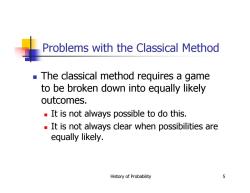
Problems with the Classical Method The classical method requires a game to be broken down into equally likely outcomes. It is not always possible to do this. It is not always clear when possibilities are equally likely. History of Probability 5
History of Probability 5 Problems with the Classical Method ! The classical method requires a game to be broken down into equally likely outcomes. ! It is not always possible to do this. ! It is not always clear when possibilities are equally likely

Experience Another method,known as the frequency method had also been used for some time. This method consists of repeating a game a large number of times under the same conditions.The probability of winning is then approximately equal to the proportion of wins in the repeats. This method was used by Pascal and Fermat to verify results obtained by the classical method. History of Probability 6
History of Probability 6 Experience ! Another method, known as the frequency method had also been used for some time. ! This method consists of repeating a game a large number of times under the same conditions. The probability of winning is then approximately equal to the proportion of wins in the repeats. ! This method was used by Pascal and Fermat to verify results obtained by the classical method
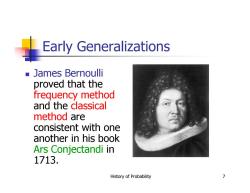
Early Generalizations James Bernoulli proved that the frequency method and the classical method are consistent with one another in his book Ars Conjectandi in 1713. History of Probability 7
History of Probability 7 Early Generalizations ! James Bernoulli proved that the frequency method and the classical method are consistent with one another in his book Ars Conjectandi in 1713
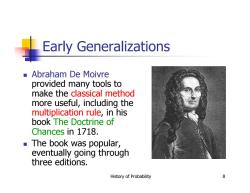
Early Generalizations Abraham De Moivre provided many tools to make the classical method more useful,including the multiplication rule,in his book The Doctrine of Chances in 1718. ■ The book was popular, eventually going through three editions. History of Probability 8
History of Probability 8 Early Generalizations ! Abraham De Moivre provided many tools to make the classical method more useful, including the multiplication rule, in his book The Doctrine of Chances in 1718. ! The book was popular, eventually going through three editions
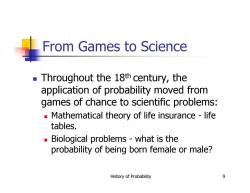
From Games to Science Throughout the 18th century,the application of probability moved from games of chance to scientific problems: Mathematical theory of life insurance-life tables. Biological problems what is the probability of being born female or male? History of Probability 9
History of Probability 9 From Games to Science ! Throughout the 18th century, the application of probability moved from games of chance to scientific problems: ! Mathematical theory of life insurance - life tables. ! Biological problems - what is the probability of being born female or male?
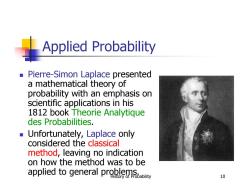
Applied Probability Pierre-Simon Laplace presented a mathematical theory of probability with an emphasis on scientific applications in his 1812 book Theorie Analytique des Probabilities. Unfortunately,Laplace only considered the classical method,leaving no indication on how the method was to be applied to general pro 10
History of Probability 10 Applied Probability ! Pierre-Simon Laplace presented a mathematical theory of probability with an emphasis on scientific applications in his 1812 book Theorie Analytique des Probabilities. ! Unfortunately, Laplace only considered the classical method, leaving no indication on how the method was to be applied to general problems
按次数下载不扣除下载券;
注册用户24小时内重复下载只扣除一次;
顺序:VIP每日次数-->可用次数-->下载券;
- 中国科学技术大学:《概率论与数理统计》课程教学资源(课件讲义)第七章 假设检验 7.3 拟合优度检验.pdf
- 中国科学技术大学:《概率论与数理统计》课程教学资源(课件讲义)第七章 假设检验 7.2 两样本正态参数的检验.pdf
- 中国科学技术大学:《概率论与数理统计》课程教学资源(课件讲义)第七章 假设检验 7.1 基本概念与重要参数的检验.pdf
- 中国科学技术大学:《概率论与数理统计》课程教学资源(课件讲义)第七章 假设检验.pdf
- 中国科学技术大学:《概率论与数理统计》课程教学资源(课件讲义)第六章 参数估计 6.2 置信区间.pdf
- 中国科学技术大学:《概率论与数理统计》课程教学资源(课件讲义)第六章 参数估计 6.1 点估计.pdf
- 中国科学技术大学:《概率论与数理统计》课程教学资源(课件讲义)第六章 参数估计.pdf
- 中国科学技术大学:《概率论与数理统计》课程教学资源(课件讲义)第五章 数理统计的基本概念与抽样分布 5.2 抽样分布.pdf
- 中国科学技术大学:《概率论与数理统计》课程教学资源(课件讲义)第五章 数理统计的基本概念与抽样分布 5.1 数理统计的基本概念.pdf
- 中国科学技术大学:《概率论与数理统计》课程教学资源(课件讲义)第五章 数理统计的基本概念与抽样分布.pdf
- 中国科学技术大学:《概率论与数理统计》课程教学资源(课件讲义)第四章 大数律与中心极限定理 4.1 大数律与中心极限定理.pdf
- 中国科学技术大学:《概率论与数理统计》课程教学资源(课件讲义)第四章 大数律与中心极限定理.pdf
- 中国科学技术大学:《概率论与数理统计》课程教学资源(课件讲义)第三章 随机变量的数字特征 3.2 方差、相关系数以及其他数字特征.pdf
- 中国科学技术大学:《概率论与数理统计》课程教学资源(课件讲义)第三章 随机变量的数字特征 3.1 中心位置数字特征.pdf
- 中国科学技术大学:《概率论与数理统计》课程教学资源(课件讲义)第三章 随机变量的数字特征.pdf
- 中国科学技术大学:《概率论与数理统计》课程教学资源(课件讲义)第二章 随机变量及其分布 2.5 随机变量的函数的分布.pdf
- 中国科学技术大学:《概率论与数理统计》课程教学资源(课件讲义)第二章 随机变量及其分布 2.4 条件分布与独立性.pdf
- 中国科学技术大学:《概率论与数理统计》课程教学资源(课件讲义)第二章 随机变量及其分布 2.3 多维随机变量.pdf
- 中国科学技术大学:《概率论与数理统计》课程教学资源(课件讲义)第二章 随机变量及其分布 2.2 连续型随机变量.pdf
- 中国科学技术大学:《概率论与数理统计》课程教学资源(课件讲义)第二章 随机变量及其分布 2.1 离散型随机变量.pdf
- 《概率论与数理统计》课程教学资源(阅读材料)The Role of Statistics in Engineering.pdf
- 《湖北职业技术学院学报》:浅谈概率中一般加法公式的应用.pdf
- 内蒙古师范大学:《概率论与数理统计》教学资源(阅读材料)数学期望的应用(一).pdf
- 内蒙古师范大学:《概率论与数理统计》教学资源(阅读材料)数学期望的应用(二).pdf
- 长沙航空职业技术学院:《概率论与数理统计》教学资源(阅读材料)数学期望的应用举例.pdf
- 《概率论与数理统计》课程教学资源(阅读材料)平均数和数学期望.pdf
- 《概率论与数理统计》课程教学资源(阅读材料)论数学期望定义中“绝对收敛”(哈尔滨金融高等专科学校:孙伟).pdf
- 《概率论与数理统计》课程教学资源(阅读材料)概率论简史(临沂师范学院:徐传胜).pdf
- 《概率论与数理统计》课程教学资源(阅读材料)概率哲学思想的几次进化(临沂师范学院:徐传胜、杨军).pdf
- 《概率论与数理统计》课程教学资源(阅读材料)ESTIMATING COMPLETION RATES FROM SMALL SAMPLES USING BINOMIAL CONFIDENCE INTERVALS - COMPARISONS AND RECOMMENDATIONS.pdf
- 中国科学技术大学:《概率论与数理统计》课程教学资源(试卷习题)期末考试2010.pdf
- 中国科学技术大学:《概率论与数理统计》课程教学资源(试卷习题)期末考试2011.pdf
- 《概率论与数理统计》课程教学资源(电子书)Introduction to Probability and Statistics with R(G. Jay Kerns,First Edition).pdf
- 国家开放大学:2013—2014学年第一学期“开放专科”金融专业统计学原理期末试题(1月).pdf
- 唐山广播电视大学:《统计学原理》课程教学资源(试卷习题)期末复习题及答案.doc
- 唐山广播电视大学:《统计学原理》课程教学资源(试卷习题)综合练习题及答案.doc
- 唐山广播电视大学:《统计学原理》课程教学资源(试卷习题)试题类型及规范解答举例.doc
- 国家开放大学:2010—2011学年第二学期“开放专科”金融专业统计学原理(B)期末试题(7月).pdf
- 国家开放大学:2011—2012学年第一学期“开放专科”工商管理专业统计学原理(B)期末试题(1月).pdf
- 国家开放大学:2011—2012学年第一学期“开放专科”金融专业统计学原理(B)期末试题(1月).pdf
